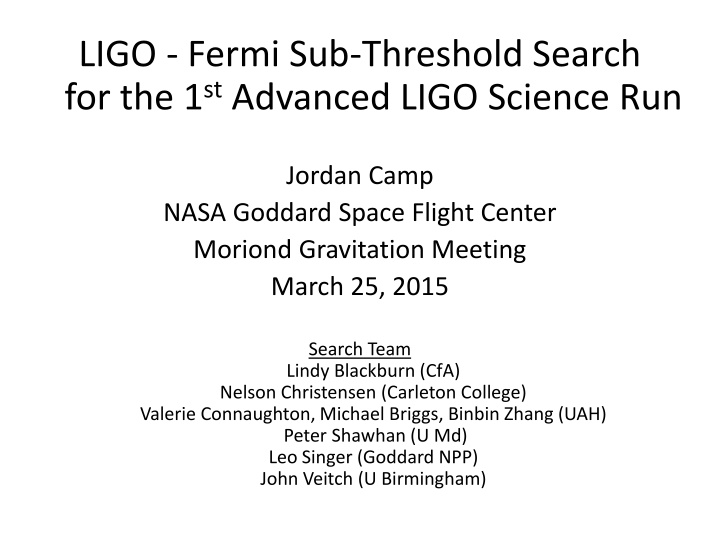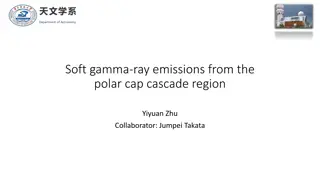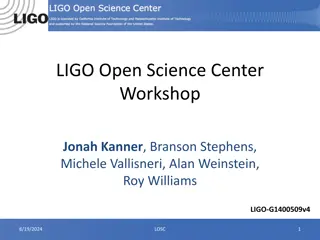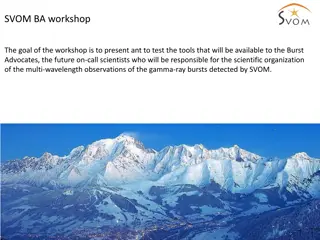Advanced LIGO and Short Gamma-Ray Burst Search Overview
Advanced LIGO is focused on achieving a lower noise level and higher sensitivity to detect gravitational waves. The search involves analyzing data from the 1st Advanced LIGO Science Run, collaboration with Fermi, and seeking coincident detections of gravitational waves and gamma-ray bursts, particularly from neutron star mergers. The joint efforts aim to enhance our understanding of astrophysical phenomena and extract valuable information about the nature of gravitational waves and neutron stars.
Uploaded on Sep 28, 2024 | 7 Views
Download Presentation

Please find below an Image/Link to download the presentation.
The content on the website is provided AS IS for your information and personal use only. It may not be sold, licensed, or shared on other websites without obtaining consent from the author.If you encounter any issues during the download, it is possible that the publisher has removed the file from their server.
You are allowed to download the files provided on this website for personal or commercial use, subject to the condition that they are used lawfully. All files are the property of their respective owners.
The content on the website is provided AS IS for your information and personal use only. It may not be sold, licensed, or shared on other websites without obtaining consent from the author.
E N D
Presentation Transcript
LIGO - Fermi Sub-Threshold Search for the 1stAdvanced LIGO Science Run Jordan Camp NASA Goddard Space Flight Center Moriond Gravitation Meeting March 25, 2015 Search Team Lindy Blackburn (CfA) Nelson Christensen (Carleton College) Valerie Connaughton, Michael Briggs, Binbin Zhang (UAH) Peter Shawhan (U Md) Leo Singer (Goddard NPP) John Veitch (U Birmingham)
Advanced LIGO is now operating Louisiana Washington Gravitational Wave causes differential arm displacement photodetector signal
Advanced LIGO Sensitivity Goal Factor 10 lower noise at high frequency Higher power laser Factor 10 lower noise at low frequency Active seismic isolation Factor 6 lower cutoff frequency Multiple suspensions in series Initial LIGO BNS range 20 Mpc Advanced LIGO BNS range 200 Mpc (Washington 28 Mpc, Louisiana 68 Mpc)
Recent LIGO Noise Spectrum Initial LIGO, 20 Mpc Advanced LIGO, 59 Mpc O1 run this summer Design Sensitivity, 138 Mpc (Laser power = 25 W)
Short Gamma-Ray Burst sGRB Fermi sGRB is most likely due to merging of Neutron Stars Inspiral of NS NS produces GW, merger produces burst of Gamma-rays Excellent candidate for coincident detection of GW and Gamma-ray Overlap of GW/Gamma-ray in time and location subthreshold detection > 100 sGRBs observed by Fermi Gamma-Ray Burst Monitor (GBM) 12 Na I detectors in varying orientations, 5 degree position resolution GW is roughly isotropic, but Gamma-ray is beamed (10 degree opening) Need sGRB within LIGO horizon (400 Mpc), and beamed at earth
LIGO GBM Coincident Search LIGO GWs 4 FoV 2 FoV 100 deg2 Fermi GBM Gamma-rays 25 deg2 NS-NS merger: Short Gamma-Ray Burst (sGRB) GBM coincidence in time and space will help verify the GW event Followup of GBM with eg Palomar Transient Facility localization host galaxy, redshift, accurate BNS parameter extraction Relative timing of Gamma-ray and GW mass of Graviton Energetics, beaming, and nature of sGRB Information on NS Equation of State ?
Coherent Analysis of GBM Detectors (L. Blackburn and UAH) data Factor 2 gain in SNR signal Instrument response noise source Evaluate by marginalizing over source amplitude, position ri provided by GBM detector model (Connaughton, UAH)
Test of Initial LIGO GBM coincident analysis L. Blackburn, ApJ S 217 (2015) LIGO BNS trigger LIGO sky localization ASM GBM 8
sGRB Precursors and NS EOS E. Troja et al, Ap J 723 (2010) 9
NS Crust Resonant Shattering Process Tsang et al, PRL 108 (2012) Available Tidal Energy ~ 1050 erg Mode Energy ~ 1047 erg Fracture Seismic Energy ~ 1046 erg Shattering Luminosity ~ 1046-47 erg 0.1 sec (can see 1047 erg at ~ 150 Mpc) Isotropic (!) 10
Investigating NS Crust Equation of State fres (from GW) at time of Precursor NS EoS 11
Optimistic O1 LIGO and sGRB Rates aLIGO BNS Detections sGRB Detections Typical jet angle ~ 10 degree beaming factor ~ 100 Thus 3 LIGO BNS detections ~ 0.03 coincident sGRB detection ~ 0.3 (subthreshold/GW on jet axis) Realistic rates likely to be factor 10 lower look to O2, O3
O1 LIGO GBM Search O1 run around fall 2015 3 months Hanford and Livingston detector range > 60 Mpc Pipeline development Further tests of GBM coherent analysis Use GBM continuous data from every downlink (CTTE) LIGO sky localization: low-latency to enable real-time alerts Run pipeline Analyze results and get ready for O2 run at > 100 Mpc Continue development of GBM coherent analysis (UAH)























